Full Copy of 'The Atlanta Zone Plan' from 1922
Article Table of Contents
- A Warning and a Request
- Context for the Atlanta Zone Plan of 1922
- The Atlanta Zone Plan: Report Outlining a Tentative Zone Plan for Atlanta
- Five Illustrations of the Need for Zoning
- What Zoning is and does
- Outline of Tentative Zone Plan
- Updates across the years
- Footnotes
update: I originally wrote this in 2020. It’s as present in my mind today as it was then. Some explanations can be found in the updates I wrote below. I might change the published date sometimes to float this up to the top of the list of blog posts.
A Warning and a Request #
In a moment, you will read the full text of a 1922 marketing pamphlet. This document is an important thread to understanding some very large political problems facing the world today, specifically housing, affordability, the growing wealth gap, and more.
update from a few years after I first wrote this post:
When i first wrote this, I downplayed what this document connects to. It was written by a supremacist, who wanted to maintain the supremacy he was clinging to, the violent oppression and exploitation of people deemed slaves.
this 1922 marketing pamphlet became “law” in the greater united states in 1926, in a supreme court case between the municipality of Euclid, ohio, and a real estate company. American-style zoning is known as ‘euclidean’ zoning, for this reason. That supreme court case obviously references this 1922 document. That style of zoning is presumed god in the USA today. The people who know enough about the space to know what ‘euclidean zoning’ is generally do not know that the person who invented it, in first penning the section about residence districts, wrote r1-white and r2-colored in it. Definitionally, american-style zoning expects all housing to be segregated by that european-american style of supremacy, hallucinations of the concept of ‘race’. ‘single-family housing’ was the supremacist fantasy of whiteness, and multi-family housing was where they poured their rejected shadow-side. It was all, of course, heavily wrapped with layers of coercive control. Womp womp. the concept of political authority is, definitionally, credible threats of violence from one group against another. yaaaaaaay!
This document tells a story. This story is about power. Most people that have true power, power that can shape entire cities and how billions of dollars get spent, don’t run around telling everyone “I’m ludicrously powerful and there’s nothing you can do about it.”
These ludicrously powerful people hide their power under layers of misdirection and distraction, and they make it look like they’re less powerful than they actually are. Like Robert Moses.1
This 100 year old marketing brochure influences your daily experiences today. Powerful people wrote that document.
Context for the Atlanta Zone Plan of 1922 #
I recently read Racial Zoning: Segregation and the U.S. Federal Government.
I’ll share a quote from the article:
Whitten then went ahead and designed a zoning ordinance for Atlanta, advising city officials that “home neighborhoods had to be protected from any further damage to values resulting from inappropriate uses, including the encroachment of the colored.”
The zone plan drafted by Whitten and unpublished by the Atlanta City Planning Commission in 1922 explained that “race zoning is essential in the interest of the public peace, order and security and will promote the welfare and prosperity of both the white and colored race.”
The zoning law divided the city into an “R-I white district” and “R-2 colored district” with additional neighborhoods undetermined (Rothstein 2017)
This quote referenced a zone plan: The Atlanta Zone Plan: Report Outlining a Tentative Zone Plan for Atlanta
I read every word of that document. It’s pictures of the original pamphelt, converted to PDF. Here’s the full document:

There’s only 15 pages with much text on them, and it is all so riveting.
I share some high points and screenshots of the zoning plan in the following thread. I’d encourage you to peruse the threads before continuing:
Thoughts on Denver’s zoning and systemic racism (Twitter thread #1) #
1/20 Thoughts on Denver's zoning and systemic racism.
— Josh Thompson (@josh_works) August 15, 2020
Here's a screenshot from @CityofDenver's zoning map on https://t.co/Tzx271JS8u.
This is textbook Euclidean Zoning, AKA "Single-Use Zoning".
The problems of this form of zoning are well-known:https://t.co/WqiklxjB4h pic.twitter.com/7RDaFJlttS
Deeper dive into connections between 1922 zoning plan and modern Denver (Twitter thread #2) #
I missed a piece in this "R-1 White District" and "R-2 Colored District" narrative outlined in Atlanta's 1922 zoning plan.
— Josh Thompson (@josh_works) August 16, 2020
The central piece of Witten's racist zoning plan was "the encroachment of the colored" in white neighborhoods. https://t.co/2gWMdsaEb8 pic.twitter.com/mej9ILqNOK
I wanted to make the text more readable/discoverable, instead of it living “inside” of this PDF, so I used a tool to extract text from the images. I’ve sprinkled some of my notes below.
Oh, and if you find this kind of thing interesting, I’m working on an interesting related project, and I’d love your help:
Want to stay up to date on these projects? Enter your email below, and you'll get an approximately-monthly newsletter from me.
The Atlanta Zone Plan: Report Outlining a Tentative Zone Plan for Atlanta #
copied from this online resource
Introduction: Purpose of Zoning #
Zoning will prevent the destruction of the comfort and value of your home through the erection nearby of a:
- Public garage
- Oil filling station
- Grocery store
- Steam Laundry
- Sanatorium
- Ice plant
- Foundry
Plan Authors #
Atlanta City Planning Commission
- James Key, Mayor, Chairman 2
- Robert R. Otis, Vice-Chairman
- Frank Pittman
- Fred J. Terry
- Hoke Smith
- Joel Hurt
- Chas. A. Wickersham
- Robert H. Whitten, Consultant
- H. D. Cutter, Jr, Engineer and Secretary
Five Illustrations of the Need for Zoning #
Note from Josh: Each of these illustrations are complex. They interleave facts and misdirection, I have a lot I could say about each sentance, but I’ll restrain myself until later in the document, as much as possile.
Illustration 1 #
A mechanic buys a home for his family in a newly developed residence subdivision. He and his neighbors plant trees and shrubs and make the section a quiet and attractive home neighborhood.
Then the adjoining house changes hands and the new owner (thinking only of his own immediate advantage) builds a small grocery store projecting to the sidewalk line and surrounds it with a litter of boxes and barrels.
Our mechanic who has invested his entire savings, $3500 [$54,000 in 2020 dollars], in his home and given a first mortgage lien for the remainder of the purchase price would like to move away and offers his home for sale but finds that it will now bring but half the amount he paid for it and his entire savings, $3500, have been lost.
He is forced to remain where he is. Not only his home but all the homes in the block are depreciated in value; as a result the owners are discouraged; the yards are neglected and the property allowed to run down.
This nice, quiet home section has been ruined and the savings of the home owners wiped out. This is an example of what is happening in one block after another all over the city. Is this the way to encourage thrift or promote home ownership?
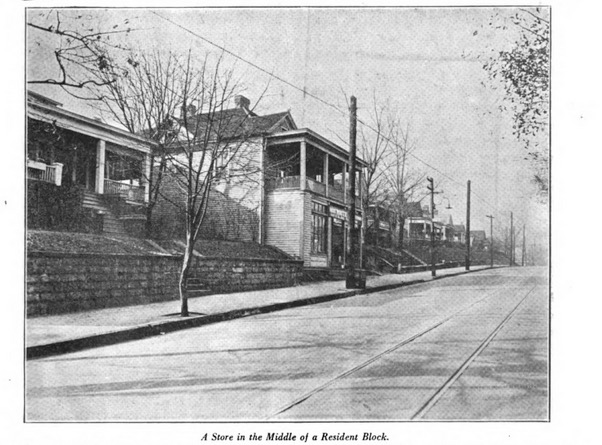
Illustration 2 #
Mr. Smith has purchased a home in an attractive neighborhood. All of the homes have large well kept yards.
Mr. Smith believes that children, like plants, must have plenty of sun light and room in which to grow. The location selected seems an ideal one in which to live and raise his family. But there is a vacant lot next door. A speculative builder estimates that he can buy that lot, erect a four story, sixteen suite apartment house thereon, rent the apartments, sell to some investor and clean up a handsome profit for himself.
The apartment house is erected and is quickly rented and sold.
It rents well because it is in a section of private homes and has the benefit of the lawns and open spaces about the adjoining houses. But the value of Mr. Smith’s home is practically destroyed. His light and air is cut off by the huge bulk of the apartment house.
The quiet and comfort of the entire block for private residence purposes has been largely destroyed.
Each home owner fears that a similar apartment building may be constructed next door to him. Those who can, sell out or move away and rent their homes for any purpose or use that offers.
Apartment houses are needed but is it necessary to permit them to scatter indiscriminately throughout the private home sections? If Atlanta is to be preserved as a city of homes we must protect the home owner by establishing definite limits beyond which the apartment house may not spread3.
Illustration 3 #
A number of large apartment houses have been erected in a block in a section near the center of the city that is being generally developed for apartment house purposes. There is a large vacant lot in the block and a speculative builder determines that in consequence of the demand for garage storage space in this apartment-house neighborhood he can make a good profit by building a public garage on the vacant lot.
The garage is built and the noise and traffic incident to its operation makes the entire block undesirable for residence purposes. The tenants of the nearby apartment houses move out and the vacant suites are only again rented at a rate that means an enormous loss to the owners4.
Zoning is just as essential for the protection of the apartment-house owner as it is for the protection of the home owner.
Illustration 4 #
Here is a large area that has been built up quite uniformly with small homes. There is a block near the center of the area that has remained undeveloped owing chiefly to the cost of bringing the lots to street grade.
An ice manufacturer picks this block as a good location for his new ice plant. The plant is built and becomes the ice distributing center for a large area. The delivery teams are stabled at the plant, and early each morning the rumbling of the wagons and the shouts of the teamsters make sleep for the nearby residents impossible.
Added to this, there is the continuous noise arising from the operation of the plant. The entire district is now undesirable for residence purposes5. Property values fall and other small shops and industries take advantage of the low prices to secure locations for their operations.
The area becomes blighted.
It is spoiled for residence use and being without railroad track facilities is of little value for industrial purposes.
Illustration 5 #
A ten story office and store building is erected at the corner of the best business block in the central business section of the city. The building is a financial success: the ground floor is rented for retail store purposes and the upper floors, being light and airy, bring good rentals.
Its success, however, leads to the erection of a sixteen story building across the street from one of its frontages, a twenty story building across the street from the other frontage and of sixteen to twenty-four story buildings on both sides and in the rear.
The offices, being darkened by the higher buildings are forced to use artificial light throughout the entire day and are rentable only at a fraction of the former amounts.
The building no longer earns a fair return on the investment. As the competition in building height proceeds a large proportion of the office floors of each building in this entire section are so darkened as to make the returns from the rentals insufficient to cover the investment6.
Unless office building heights are strictly limited the result is bound to be disastrous to the investors as well as injurious to the health and comfort of the clerks working in the darkened offices.
What Zoning is and does #
Josh: We’re getting closer to the author’s revealing their true colors. Just keep in mind the authors have a strong preference to keep black people out of white neighborhoods.
Zoning is a conscious, intelligent effort to direct the building of the city in accord with a well-considered plan7. Like good housekeeping it provides a place for everything and tries to keep everything in its place. Like good industrial management it plans for an orderly growth and expansion of the plant.
Zoning divides the land area of the city into residence, business and industrial districts and prevents the erection of business and industrial buildings in the residence districts or of industrial buildings in the business districts8.
Zoning prevents the development of great blighted areas near the heart of the city. Unless some definite limit is fixed to the distance to which business may spread out from the central business area one block after another is abandoned by the resident owners until great areas are affected that will never be needed for business and the typical blighted district results9.
St. Louis has one of the best examples of this wasteful development10.
Zoning will centralize local business in well-defined local business centers. This will facilitate the transaction of business. It will improve land and rental values in the business sections, while at the same time conserving values in the residence sections11.
Zoning will keep the apartments out of the private house sections. The coming of the apartment drives out the private home. Only by setting definite limits to the spread of the apartment can the city be preserved as a city of homes12.
Zoning will prevent congestion of population. In addition to confining tenement house construction to certain areas, zoning will prevent excessive crowding even in the tenement areas. This will be accomplished by requiring a minimum number of square feet of lot area for each family for which the tenement is arranged13.
Zoning is essential to preserve the morale of the various neighborhoods or communities into which the city is divided. Zoning creates confidence that the existing character of the neighborhood will be preserved14. Such confidence is essential to the improvement of the area and to the maintenance of a vigorous civic pride and spirit.
Zoning requires each owner so to use his property as not to injure his neighbor. Without zoning the individual owner is powerless to prevent the destruction of the value of his property15. Only by submitting to some restriction on his power to do with his own just as he pleases is he himself able to obtain protection. Zoning is a practical application of the Golden Rule to the use of property.
Zoning enforces a certain degree of co-operation among property owners for their mutual advantage and protection. A certain degree of uniformity in the development of a block or area is beneficial to all owners. This is the meaning of restrictive covenants in all better-class residential developments. Zoning applies the principle of the restrictive covenant in so far as it can be used to promote public as distinct from purely private ends.
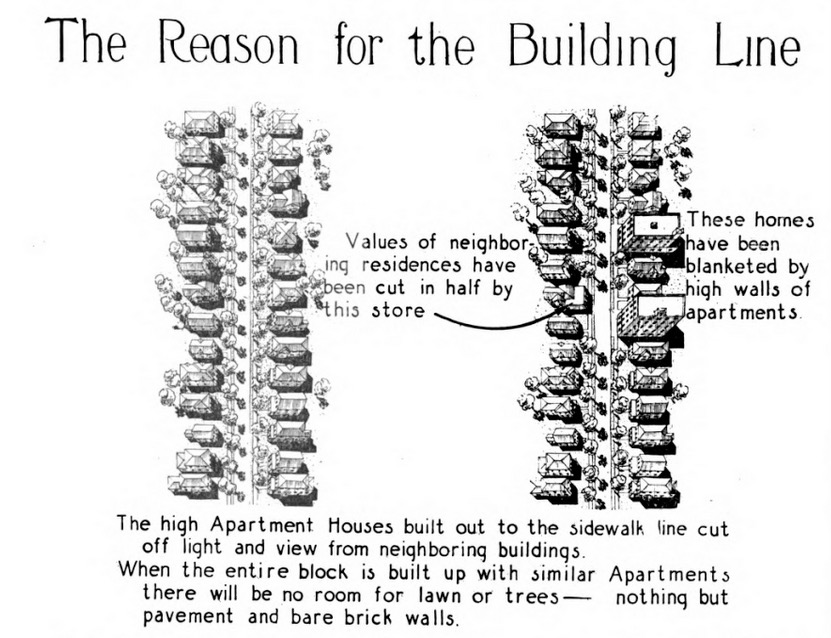
The growth of cities has made it necessary to modify former ideas both of personal library and property rights. What a man can be allowed to do and what uses he can be allowed to make of his property depend on whether he lives on a 100 acre farm or in the middle of a city block.
With the growth of the city it becomes more and more necessary to distinguish between liberty and license both as applied to persons and to property. Property in a city is “affected with a public interest.” Its value is a joint product of individual initiative and community growth. Its misuse can bring irreparable injury to the community and to property owners generally. It must submit to control both in the public interest and for its own preset vation.
No useful trade or industry is in itself a nusiance; but any trade, industry or other use of property may become a nuisance if located in violation of an appropriate and orderly plan of city development.
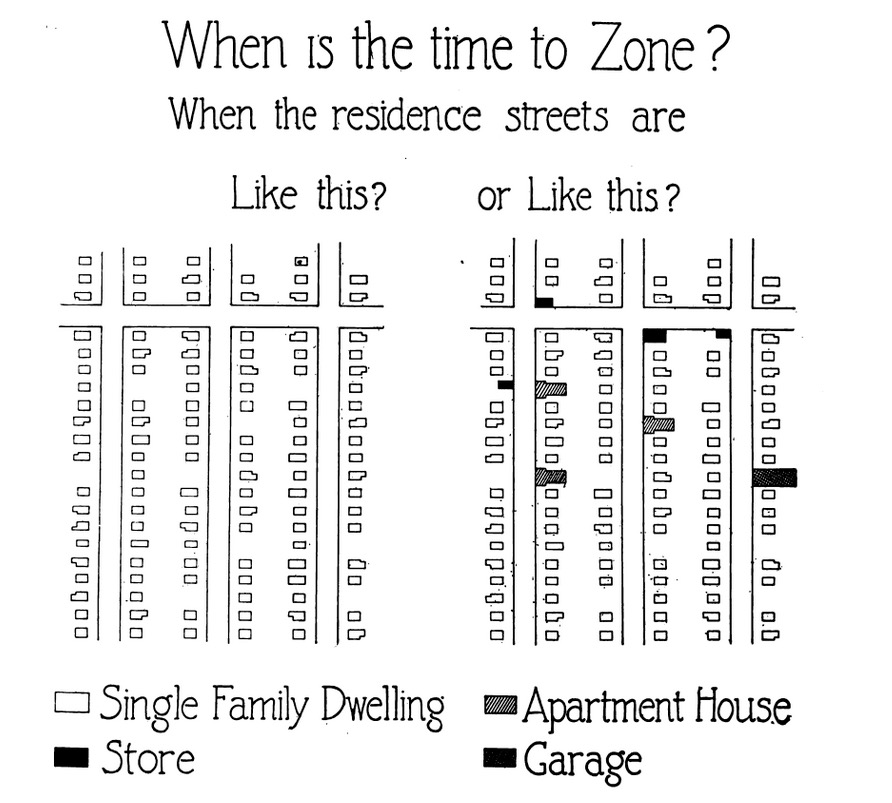
Zoning will limit the height of buildings differently in different parts of the city. The height limits will be those appropriate for the various classes of use. No owner will be permitted to appropriate for the use of his building an undue share of the common stock of light and air. Without a height limit the tendency is for each new office or hotel building to push up higher than its neighbors in order to get more light and air. This competition to build the highest building with its attendant street traffic congestion will be stopped by zoning.
Zoning will conserve property values. Haphazard development is bound to be costly and uneconomic development. Zoning will save enormous waste in building construction. With uncontrolled building development the construction of a new building in a neighborhood often means a net loss in the aggregate value of the building of that neighborhood. With zoning, each new building increases the aggregate value in an amount equal to and usually in excess of its own cost.
Zoning will attract money to a city for investment in real estate. Large lending institutions will be inclined to favor those cities in which their investments will be afforded the safeguard of a comprehensive zoning plan. Failure to provide the zoning safeguard is as inexcusable as failure to protect property against destruction by fire.
Zoning protects the home. Quiet and freedom from the distraction incident to trade, industy and attendant street traffic are essential to a wholesome home environment.
Zoning will establish uniform building lines in the residence sections, thus giving opportunity for a front yard with a lawn and trees and preventing one building from pushing out in front of its neighbors.
Zoning will promote industrial development. It will set aside adequate areas for industries within which the new plant may locate without incurring the criticism and continual complaints of neighboring residents and owners. It will attract to the city and to the home areas near the industrial areas a good and abundant labor supply. The segregation of industries will make it possible to serve the industrial areas more ef efficiently and more economically with sewers, trucking routes and freight facilities.
Zoning promotes the health and comfort of the people. Orderly city growth cannot fail to have a marked effect on the physical fitness and vitality of the city’s inhabitants. The rapid increase in nervous and organic disorders has some very definite relation to the congestion, noise and confusion incident to the existing haphazard and uncontrolled building development.
The New York Zoning Commission said:
The necessity for reducing the stress and strain of city life is becoming more and more apparent. This is essential if the city is to be a place in which our heritage of health and vitality is to be used, conserved and handed down to succeeding generations instead of being abused and exhausted.
Outline of Tentative Zone Plan #
The zoning amendment of the city charter provides that zoning plans may be prepared by the City Planning Commission and that such plans if adopted by the General Council after public hearing have been held shall have the force of law. It is fully realized that plans of this kind, before being adopted, should have the benefit resulting from their study and criticism by property owners and civic and business organizations throughout the city. The plan herewith presented is not a final plan, but merely a tentative draft to secure public suggestions and criticism.
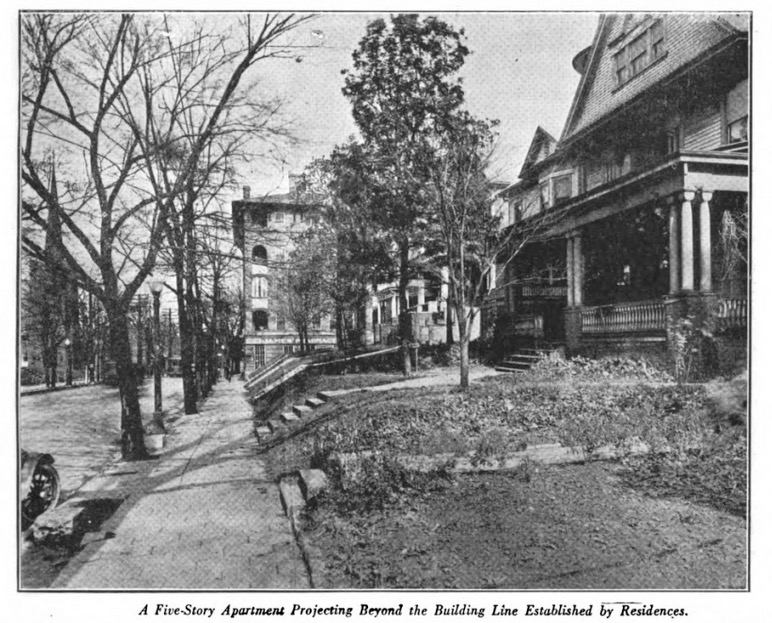
It is proposed that this tentative plan shall be taken up in detail with the members of the General Council, with citizens interested, and with civic and commercial organizations and as a result of the recommendations thus received a final plan will be prepared for submission to the Commission and the General Council. It is expected that the final plan will be the result of the joint efforts and best thought of all concerned in the direction of building development along orderly and well considered lines of city growth.
The city of Atlanta is divided into six classes of use districts. Two of these are residence districts and four are business and industrial districts. In addition to the use districts there are four classes of height districts and five classes of area districts. The height and area districts are superimposed over the use districts.
Consequently, each portion of the city is in some one of the six classes of use districts, in some one of the four classes of height districts and also in some one of the five classes of area districts. The boundaries of the various use, height and area districts are shown on the zone map.
Residence Districts #
THE two classes of residence districts are:
- Class UI or dwelling house district.
- Class U2 or apartment house district.
A building arranged for more than two families may not be constructed in a dwelling house district. One of the chief purposes of the zone plan is to preserve Atlanta as a city of homes.
While a certain number of apartment houses are beneficial, they should not be allowed to drive out the private homes in all sections of the city. Carefully limited but adequate areas are allowed for apartment house developement. The dwelling house districts, from which apartment houses are excluded, will include the larger portion of the entire area of Atlanta16.
Trade and industry are excluded from the residence districts17. Churches, schools, libraries, etc., are permitted in the residence districts. Hospitals, sanitariums and institutional buildings are permitted in those blocks of the residence districts already occupied by similar buildings. They will also be permitted in other locations with the approval of the board of zoning appeals.
Race Zoning #
The residence districts are further subdivided into three race districts:
- R1 or white residence district.
- R2 or colored residence district.
- R3 or undetermined race district.
In the white residence districts no house not occupied by a colored family at the time of the passage of the zoning ordinance can be thereafter occupied by a colored family.18 In the colored residence districts no house not occupied by a white family at the time of the passage of the zoning ordinance can be thereafter occupied by a white family.19
Servants quarters located on the same lot as the residence they serve will nevertheless be allowed in either districts without distinction to race20.
Certain limited limited residence areas are placed in neither the white district nor the colored district but are left undetermined as to the race zoning. The above race zoning is essential in the in interest of the public peace, order and security and will promote the welfare and prosperity of both the white and colored race. Care has been taken to prevent discrimination and to provide adequate space for the expansion of the housing areas of each race without encroaching on the areas now occupied by the other.
Business and Industrial Districts #
There are four classes of business and industrial districts:
- Class U3 or local retail store district.
- Class U4 or commercial district.
- Class U5 or industrial district.
- Class U6 or industrial (semi-nuisance) district.
In the local retail store (class U3) district retail stores, offices and small shops for custom work or for the making of articles to be sold at retail on the premises are permitted. The uses permitted in the residence districts are also permitted in the local retail business district.
Public garages, light manufacturing and bulk storage are excluded from the local retail business district. This district is suitable chiefly for the smaller retail centers adjacent to the resident tial sections. The attempt has been to provide small areas for neighborhood stores at half-mile intervals throughout the resident sections.
The commercial (class U4) district regulations permit in addition to all uses permitted in the local retail business district, light manufacturing of a non-nuisance character and also public garages, bulk storage and wholesale business. The commercial districts will include most of the central business sections and some of the local business sections along the main traffic arteries and street car lines.
In the industrial (class U5) district all heavy industrial uses of a comparatively non-nuisance type are permitted in addition to all the uses permitted in the residence and business districts.
Most of the area appropriate for industrial development extending out through the industrial housing areas along the railroads should be placed in the class U5 district and thus aid in the spreading out of the industries and of the industrial population.
In the semi-nuisance industrial (class U6) district such uses as boiler making, structual iron works and junk yards are permitted. This district provides for industries that need to be distributed in various industrial sectors about the city but are detrimental if immediately adjacent to residences. The nuisance features, usually noise, smoke or odor, extend up to about 1,200 feet from the industry, thus making the vicinity undesirable for certain other types of industry and very undesirable for housing.
Fertilizer plants, glue factories, slaughter houses and similar industries are classed as nuisances and under the zone plan will not be permitted to locate within the city limits.
The excluded nuisances are those that affect a very wide area with these exceptions the purpose of the four business and industrial districts is to provide locations for all types of business and industrial use with a minimum of inconvenience and waste and a maximum of efficiency.
A manufacturer of food preparations may be seriously injured by the location nearby of a chemical plant. Moreover certain types of business and industrial use may be lo city close to good residential sections without material injury while other types if located within a quarter of mile of such sections are distinct nuisances.
It is only by carefully grading the various trade and industrial uses according to their comparative freedom from nuisance characteristics that an orderly and efficient development of the city can be secured.
The zoning regulations also provide that such special uses as a cemetery, crematory, aviation field, sewage disposal plant or refuse dump may be located only on application to and with the approval of the board of zoning appeals.
Height Districts #
The entire city is divided into four classes of height districts. The maximum limits are 35 feet, 50 feet, 100 feet and 150 feet, and the height districts are termed respectively class H1, H2, H3 and H4.
In the class Hı height district the height limit is 2 1/2 stories but not in excess of 35 feet21. The one and two family dwelling and the two story apartment sections will generally be placed in the class H1 district. This class will therefore include most of the residence sections.
In the class H2 height district the maximum height is 50 feet. The 50 foot limit permits the erection of the ordinary four story apartment or the four story commercial building.
In the class H3 height district the maximum height is 100 feet. The 100 foot limit provides for the ordinary eight story office or factory building. Most of the industrial areas will be included in this district.
In the class H4 height district the maximum height is 150 feet. This 150 foot limit provides for the ordinary twelve story office or hotel building. The class H4 district will include that portion of the central business area where the most intensive office and hotel dedevelopment is anticipated.
There are at present only seven buildings in the city over 150 feet in height. Our streets in the business section are so congested that it is imperative that the height of buildings be strictly limited so as to spread out the areas of intensive use. The widths of the streets will not take care of the traffic of a three story city and it will be absolutely disastrous to burden them with the traffic of a twenty or thirty story city.
Values in the high grade shopping sections can best be maintained by encouraging the spreading out of the business area and the reservation of such sections for retail business and the traffic incident to retail business. The proposed height limit of 150 feet will tend to spread out the business district and will tend also to reduce traffic congestion and maintain values in the best retail business sections. The experience of New York and other large cities is that excessively high buildings are un-economic and very undesirable from a public standpoint22.
A single high building may pay as it takes its light and air from above its neighbors; but when this first skyscraper becomes surrounded by buildings of similar height, light and air are cut off and only the upper floors can be leased at remunerative rentals. The occupants of the darkened offices on all the other floors must use artificial light throughout the
day. By restricting all buildings to a reason ble height, so that when the business area is solidly built up, most of the floors of every building will have a fair supply of daylight, enormous economic loss will be avoided and the health of the people occupying offices and shops in the buildings will be conserved.
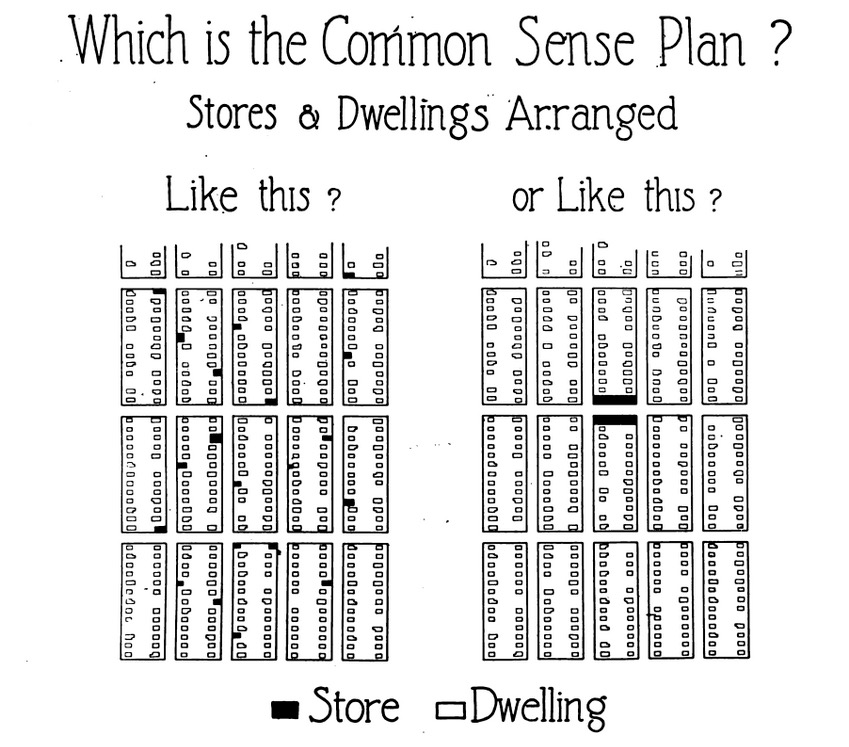
Area Districts #
The entire city is divided into five classes of area districts:
- Class A1 requiring 5000 sq. ft. of lot area per family
- Class A3 requiring 1250 sq. ft. of lot area per family.
- Class A4 requiring 625 sq. ft. of lot area per family.
- Class A5 with no required lot area per family when applied to commercial districts.
The area districts are superimposed over the height and use districts. The area district regulations are intended to promote an approprate distribution of population and to resist the tendency toward the congestion of population. The requirement of a specified number of square feet of lot area per family is based on the number of housekeeping units or families for which the building is arranged or designed.
On a lot of 40 feet by 125 feet a single family house can be constructed in a class A1 district; a two family house in a class A2 district; a four family house in a class A3 district; and an eight family house in a class A4 district. A more intensive development is in cach case allowed on corner lots.
The class A1 district requiring 5000 sq. ft. of lot area per family is applied in those sections of the city where a single family house is the most appropriate development. The two family house is prohibited in A1 districts.
The residence actions that seem appropriate for improvement with either a single family house on a small lot or a two family house on a lot having 5000 sq. ft. of lot area are placed in the class A2 district where the requirement is 2500 sq. ft. of lot area per family. Most of the apartment house districts will be in the class A4 districts requiring 625 sq ft. of lot area per family. This will permit an eight family apartment house on a lot 40 feet by 125 feet. Other apartment house areas will be placed in the A3 district which will permit the housing of but for families on the same size lot.
The requirement of a certain number of square feet of lot area per family applies to residence buildings whether they are within the residence districts or are constructed within business or industrial districts. In computing the number of families that may be housed on a given lot area, deduction is made where a portion of the lot is used for business or industrial purposes. Thus in a class A3 area district where, for example, four families might be housed on a 40 ft. by 125 ft. lot, if there are stores occupying 2000 sq. ft. of area on the ground floor, the number of families that can be housed on the lot is reduced by one, or in other words there is a reduction of one family for each 2000 sq. ft. of lot area occupied for business purposes.
The ordinary two or three story store and dwelling building is not a desirable type of construction from a public stand point. The regulations as applied will tend to reduce the number of flats that would otherwise be located over stores. The erection of dwellings or apartment houses is not prohibited in the industrial districts, though for the most part these districts are so located that there would be little tendency to build residences within them.
It is, of course undesirable for many reasons to have residences and factories intermingled. The factories do not create a proper environment for the home, and the nearness of the home to the factories subject the factory owners to the complaints of the residents because of the nuisance features incident to the normal operations of the factories.
While the zone plan does not prohibit the erection of residences even in the semi-nuisance industrial districts, it will tend to discourage the erection of dwellings therein for two reasons:
- first, with definite areas set aside for residences and factories, the financial hazard incident to the placing of residences in a factory zone will, in most cases, serve as a suf ficient deterrent;
- second, the semi-nuisance in industrial districts will be placed in the A1 area districts which will require 5000 sq. ft. of lot area per family. This will further tend to make the erection of a residence in one of these districts uneconomic.
Side and Rear Yards #
Side and rear yards are required in all residence districts. In business and industrial districts, side yards are not required, but rear yards are required where such districts adjoin residence districts.
The zone plan does not attempt to provide a complete code for the lighting and ventilation of the building. It simply establishes minimum standards for those open spaces about the building that have a relation to the lighting and ventilation of the adjoining buildings as well as to that of the building itself. The zone regulations are thus confined to those things in which adjoining owners have a mutual interest. Side yards, rear yard and front yard spaces are required for the mutual advantage of all owners and occupants of the block. The provision or omission of an interior court, on the other hand, does not affect the neighbor.
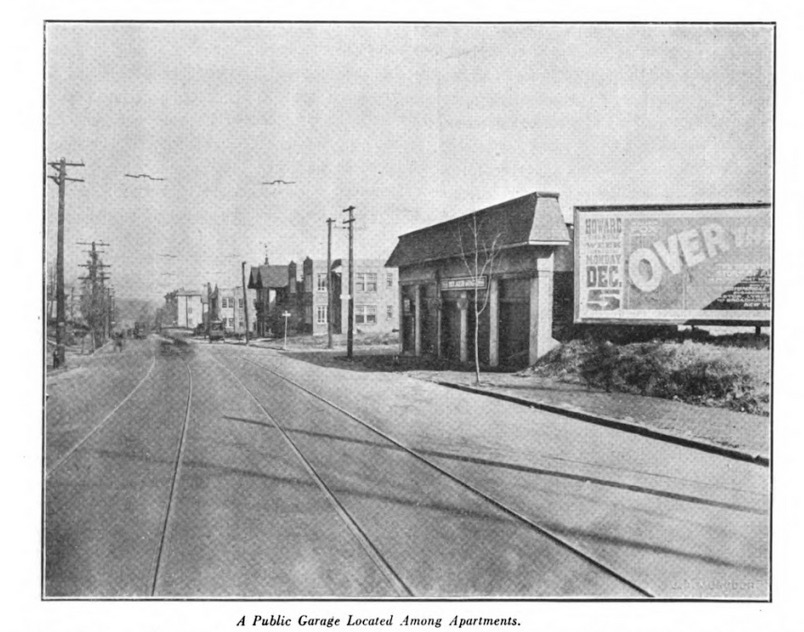
Front Yards: Building Lines #
Atlanta has been generally developed with residences setting well back from the street line, affording adequate room for lawn and trees. This makes a healthful and convenient city as well as beautiful city. Grass and trees make an attractive home environment and are almost essential to a normal, healthful development of the child.
Occasionally, in a detached residence section, an apartment house disregards the existing building line and is erected at or near the street line. This cuts off light and air from the neighboring buildings and if it becomes a type will entirely change the character of our residence sections. Atlanta will tend to reproduce conditions obtaining in certain other cities where there are great areas with apartment houses erected right on the street line and with out a bit of vegetation-nothing but the pavement and the bare brick walls. We can pre vent the reproduction of such conditions in our residence sections by maintaining the existing building lines.
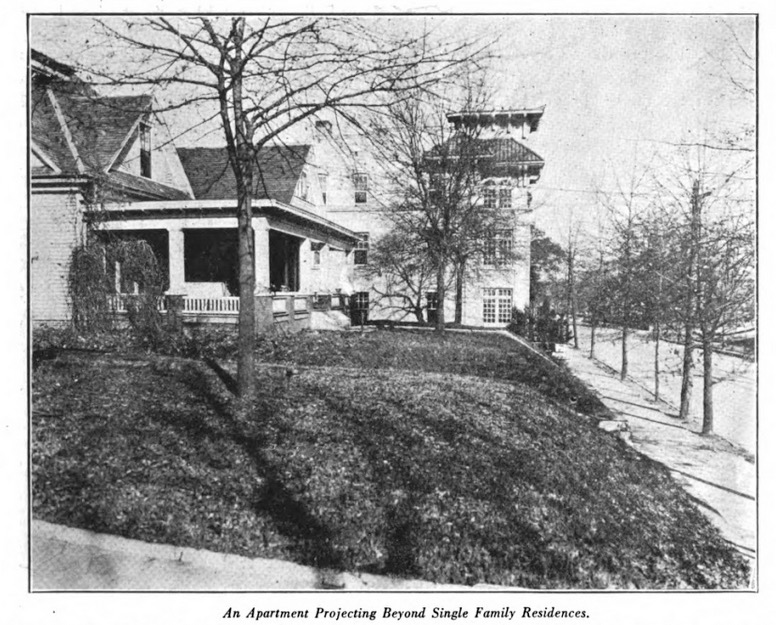
Classification of Uses #
The classification of uses which is a part of the zoning ordinance divides the various uses of property into groups, classes and subdivisions. The use classes correspond to the use districts. Each use class lists the uses for which the corresponding use district class is specially designed to provide. Starting with the private dwelling, the classification enumerates the various kinds of residential use and then the business and industrial uses graded and arranged according to their comparative freedom from nuisance characteristics. In the hierarchy of uses the dwelling comes first and garbage reduction and fertilizer plants last.
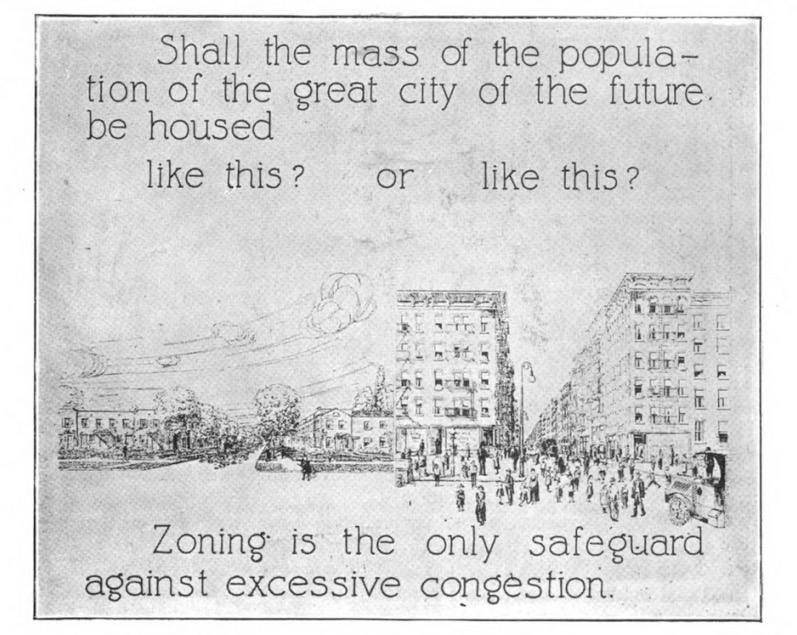
Non-conforming Uses #
The zoning ordinance does not affect existing uses of property. A use or building existing at the time of the passage of the zoning ordinance which does not comply with the regulations of the use district in which it is located is called a non-conforming use. Such use or building may be continued though not conforming to the use district regulations. The zoning ordinance is not retroactive. If, for example, there is a store in an area that under the zoning ordinance is included in a residence district the store may nevertheless be continued. A non-conforming use may also be changed subject to the general rule that, if changed, it must be to a higher use as listed in the classification of uses. If, however, the non-conforming use is a class U6 (semi-nuisance) use or class U7 (nuisance) use it may not be changed unless to a conforming use. A change to another use listed in the same subdivision of the classification is not deemed a change of use under the ordinance. Thus a change from a grocery store to any other kind of a retail store or shop would technically be deemed a continuance of the existing use.
A building housing a non-conforming use may not be structurally altered to an extent exceeding during any ten year period 60 per cent of the assessed value of the building23.
While, therefore, an existing non-conforming use may be continued the limitations imposed on a change of use and on the reconstruction of the building housing the non-conforming use will eventually bring about the elimination of the non-conforming use24.
Enforcement: Board of Zoning Appeals #
The zoning ordinance will be enforced by the inspector of buildings25. No building permit will be issued unless the building and its proposed use conform to the zoning regulations.
In the application of the zoning many cases will arise, especially near the dividing line be tween two use districts, where the strict letter of the zoning regulations may properly be modified. This can be done in specific cases with out injury to general public purposes of the ordinance, while at the same time avoiding unnecessary injury to the individual owner.
Strictly limited discretion is therefore lodged in a board of zoning appeals created by the ordinance to make minor modifications and exceptions to the general rules and regulations established by the ordinance.
Amendment of Zone Plan #
The Council will have full power to amend or supplement the zoning plan. Minor changes will be necessary to correct imperfections in the plan. Other amendments will be required to meet changing conditions of city growth. It is to be expected that the plan will be supplemented and changed when certain fundamental factors affecting the physical structure of the city have been fully worked out.
While provision should be made for necessary changes, the method of such change should be safeguarded so as to prevent hasty and ill-considered action. A zone plan in order to afford the protection for which it is designed should be fairly permanent. Those who build in accordance with its provisions should feel reasonably sure that their investment will not be jeopardized by changes in the district lines. On the other hand, the method of change should not be so difficult as to make it impractical to conform the zone plan to changing conditions of city growth.
Under the zoning ordinance any amendment proposed must secure a three-fourths vote of the Council for adoption26, and before voting on such amendment the Council is required to submit the amendment to the city planning commission for its recommendation27. If an amendment is proposed by the petition of the owners of 50% of the land in the area to be changed, Council must vote on such amendment within 90 days28.
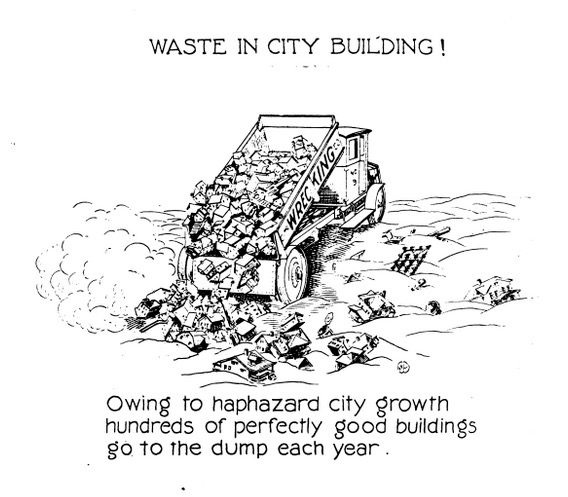
Building the Future City #
Zoning is a first essential to the securing of a measure of orderliness in the building of the city. The common sense of the average citizen leads to a degree of order in the home, the store and the factory that is all but lacking in the life and work of the community as a whole. For want of a well-considered plan of building development each man builds without reference to his neighbor. The result is chaotic. Haphazard growth is inefficient, wasteful and ugly. Why not use the same forethought and care in the building of our community home that each sane man uses in the building of his individual home or factory? Zoning is the direction of building development along orderly and well-considered lines of city growth. On the economic side, zoning means increased industrial efficiency and the prevention of enormous waste. On the human side, zoning means better homes and an increase of health, comfort and happiness for all the people.
And that is the end of the 1922 Zoning Plan!
Like I’ve mentioned before, I’m working on projects in this space. I’d love to have your help:
Want to stay up to date on these projects? Enter your email below, and you'll get an approximately-monthly newsletter from me.
Updates across the years #
I could have, maybe wish I had, done more incremental updates to this post. Since writing it, I’ve written many other stand-alone pieces that are thematically related, but never updated this piece itself. I’ll do some back-filling. I’m writing these updates long after I’ve written some of these pieces:
- zoning regimes very different than ours it’s a substack, of course. In it I was/am simply discussing zoning regimes, in the style of a book titled ‘legal systems very different than ours’. the first post of the substack explains the name more
- parking minimums as ethnic cleansing is an attempt at a partial answer to ‘gosh, josh, why do you dislike some things about american style parking lots so much?’
2025 #
I’ve referenced this document quite a few times since 2020, the year I first discovered the document and did this write-up.
For instance, I once showed up at a neighborhood zoning meeting (right after doing this write-up), and while everyone was mixing and mingling about a proposed modification to the zoning code (a neighborhood zoned r2, where I lived at the time, yet almost every attendee lived in an adjoining r1 neighborhood).
I asked the then director of planning and zoning for the city of Golden (Rick Muriby, Director of Community and Economic Development), if he know about this wild thing I’d just encountered, ‘the racialized origins of american-style zoning’?
As I recall, he gave a bit of a smirk - not shock or fear or discomfort or whatever, and silently turned around and walked away.29
Few people capable of reading today will explicitly defend supremacy, and the ones who do defend it explicitly are so odious that everything about them is off-putting, thus to join them is to sorta willingly cede influence, and the possibility of being taken seriously by anyone of dignity or interest.
Please remember that r1 zoning is virtually synonymous with ‘single family housing’ is virtually synonymous with ‘the suburbs’.
Here’s a quote from Golden’s zoning code, today:
Residentially zoned area. “Residentially zoned area” means an area zoned for the development of residential dwelling units, including the CO, AG, RE, R1, R1A, R2, R3 zone districts, and portions of PUD developments designed for such use.
I think a ‘proper appreciation’ for the origin of such designations lead to conversations vastly more interesting about American-style zoning than are otherwise available.
I, personally, notice fatigue or boredom settling in on me when I am overhearing people speak seriously about modern american-style zoning, residence districts, the suburbs, all of it.
to have one’s life affected by something like race districts/residence districts is to have ones life grievously affected by the ongoing effect of a supremacists willingness/desire to coerce their supremacy and beliefs and fears and griefs upon the world around them.
Footnotes #
-
After this document from 1922 was sorta ‘ratified’ by the american supreme court in Euclid vs. Ambler (1926), it got labelled ‘euclidean zoning’ or ‘form-based zoning’. Robert Moses got his hands on it, and as reported early in The Power Broker: Robert Moses and the Fall of New York, he spread this municipal form of government all around new york city and state. he’s more responsible for the built environment of the globe today than anyone else conceivable. (literally the geometry of roads, highway onramps, features multiplied across the world in asphalt, steel, and concrete like leaves on a tree.) He invented ‘urban highways’, ‘eminent domain’ in the modern sense, slum clearence/urban renewal, the federal highway administration, and much more. ↩
-
Only now did I realize the mayor signed his name on this document. This document is explicitely racist, and the mayor was certainly not trying to move the Overton window. That means nothing in this proposal would jepordize the mayor’s political future. This is a plan by racists and for racists. ↩
-
The plan buries the lede. They are going to soon propose creating
R-1 White Districts(which ban apartment buildings) andR-2 Colored Districtswhich permit small apartment buildings. The author also argues that a principle purpose of this zoning plan is to prevent the encroachment of Black people on White neighborhoods. ↩ -
I actually agree with this assessment. Living next door to a parking garage is unpleasent and damages property values. Ironically, our modern zonign paradigm forces the creation of parking garages where they would otherwise never exist, and forces the harms it claims to defend against. ↩
-
Long commutes are expensive, harmful to the environment, pocketbook, and soul. How nice would it be to live next to where you work? If I read Illustration 4 with the perspective of someone who works at the ice plant, I would be a big fan of being able to live near where I worked. ↩
-
I laughed a little as I read this. I’m sure in 1922 a 20-story building was rather large and uncommon. I think we’ve all grown up with enough tall buildings that we can reject this assessment as categorically false, based on our lived experience. Every urban area has tall buildings (50 stories, 100 stories tall!) and the adjacent buildings go up in value, not down. ↩
-
We could re-word this sentence to:
Zoning is a conscious, intelligent effort to
directenforce the building of the city in accord with awell-consideredsupremacist plan. -
screenshot zoning codes from Denver that show restrictions of commercial activity in residential zones ↩
-
The author is describing a phenomena known as “white flight”, but without labeling it as such. ↩
-
St. Lewis has horrific history around racism. I’ll add links here soon. Just know that alarm bells should be going off in your head, as you read this reference to St. Lewis. ↩
-
The authors are arguing for “Euclidean zoning”. There’s no question that Euclidean zoning encourages sprawl and car-dependence, accomplishing the exact opposite of what the authors say zoning will accomplish. My first twitter thread goes into this phenomina in some detail. ↩
-
Remember that the authors associate apartment buildings and black people. They should have written
Zoning will keep the Blacks out of the White neighborhoods. The coming of the Black drives out the White. Only by setting definite limits to the spread of the Blacks can the city be preserved as a city of Whites.↩ -
This sentiment is what gives us “minimum lot size requirements”, which are, again, everywhere in modern zoning codes. (screenshots? I can add screenshots) Oh, and this is where our density limits come from. ↩
-
This sentance is why so many “pro-density” advocates claim that anyone who mentions ‘preserving neighborhood character’ is racist. They’re wrong - neighborhood character is an AMAZING thing to preserve, but our modern form of zoning just happens to be a pretty bad way of going about it. Neighborhoods can be preserved even as they adapt to the needs of the people that live there, as everyone becomes better off and more satisfied with where they live. ↩
-
Of course we should not injure others. This sentance is tricky because what it’s really saying is
Without zoning the White owner is powerless to prevent a black person from modifying their property as they see fit.↩ -
Translation: This zoning plan bans apartment buildings from most of the city. ↩
-
Translation: This zoning plan bans all commercial activity from most of the city. ↩
-
Translation: In an R1 district, it will become illegal for a black person to buy or rent property from a white property owner. ↩
-
Translation: In an R2 district, it will become illegal for a black property owner to sell or rent their property to a white person. ↩
-
Translation: White people who own slaves or have servents get a blanket exclusion from all this zoning limits we’re about to place on R1 (white single-family home) districts. ↩
-
Would it be strange if we found many, many references to a 35 foot height limit in zoning codes across the nation? I predict it would be uncomfortable. (most of the land in american cities has a 35 foot height limit) ↩
-
Now that we have 100 more years of experience with cities like New York City, I don’t think one can accept at face value the proposition that “excessively high buildings are uneconomic and very undesirable from a public standpoint”. Based off of the price of land in NYC, many, many people desire to live there. ↩
-
Translation: If a given building is “non-conforming” and assessed at a value of $50,000 (for example), if you spend more than $30,000 on renovations over a ten-year period, you are required by law to bring the entire building into ‘conforming uses’, which means you may spend more on bringing the building “to code” than you wanted to spend on the renovation. Sprinkler systems and elevators are very expensive. Most old neighborhoods are non-conforming This single clause causes near-endless fiscal trouble for property owners, cities running out of money, and renters ↩
-
Remember the goal of this “non-conforming use” section. It’s to force compliance with zoning laws over time, and it’s dammned effective. 40 percent of the buildings in Manhattan could not be built today ↩
-
Local law enforcement is often an arm for zoning enforcement. This article is an amazing investigation into long-term abuse of policing powers in Florida. One of the themes is “police harass residents”. You don’t have to read the whole article, just notice how they use zoning code to harass residents, including issuing mandatory court appearances, and if the person failed to show up or pay the fine, the police would arrest them:
If the targets, their family members or associates wouldn’t speak to deputies or answer questions, STAR team deputies were told to look for code enforcement violations like faded mailbox numbers, a forgotten bag of trash or overgrown grass, Rodgers said. The father of one Sheriff’s Office target was fined over the numbers posted on his house. The numbers were there, the document notes in the top-right, but a nearby light made them hard to see. The form indicates the father had to attend a mandatory court hearing.
Pasco Sheriff’s Office:
“We would literally go out there and take a tape measure and measure the grass if somebody didn’t want to cooperate with us,” he said.
Rodgers said people sometimes would fail to pay the fine, which would result in a warrant being issued for their arrest.
“We’d get them one way or another,” he said.
Rodgers said the tactics made him and many of his colleagues uneasy. He thought the strategy was both ineffective and unethical, he said. But when he raised concerns, he said, a supervisor threatened to strip him of his rank and send him back to patrol.
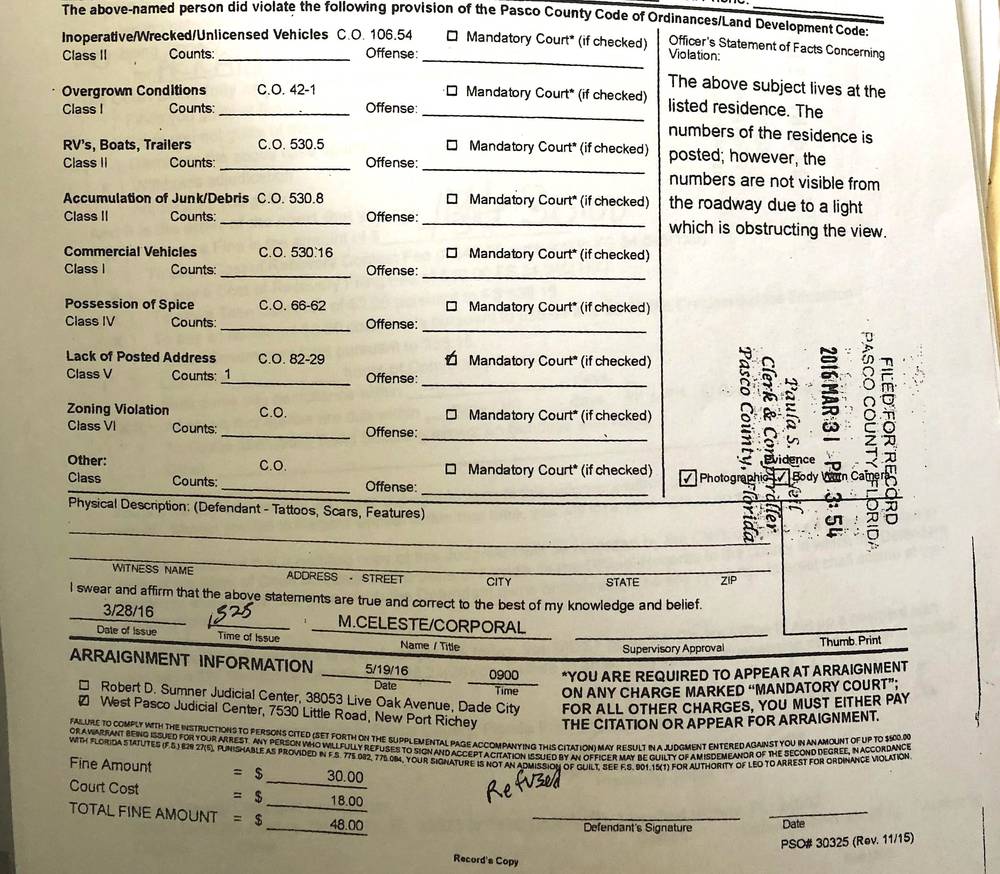 The father of one Sheriff’s Office target was fined over the numbers posted on his house. The numbers were there, the document notes in the top-right, but a nearby light made them hard to see. The form indicates the father had to attend a mandatory court hearing. ↩
The father of one Sheriff’s Office target was fined over the numbers posted on his house. The numbers were there, the document notes in the top-right, but a nearby light made them hard to see. The form indicates the father had to attend a mandatory court hearing. ↩ -
Remember, the mayor signed his name on this supremacist document. No way will 3/4ths of the city council sign off on anything that diminishes institutionalized supremacy/european american nobility norms. ↩
-
🤔 I wonder how supremacist the city council in Atlanta in 1920 was. How about 1950? 1980? 2010? 2020? 2025? ↩
-
I laughed out loud as I read this last line of the paragraph. This zoning regime is carefully sculpted to look like it’s responsive to the inputs of “the people”, but it’s really responsive to the inputs of only politically powerful people, like the mayor who put his name on this supremacist plan. ↩
-
I don’t remember if I used the word ‘racialized origin’, which is technical and very specific, or if I used the phrase ‘race-based origin’.
racializedmeansmake racial in tone or character, andcategorize or divide according to race.. It’s the same as enslaved, segregated, ghetto-ized, interred (internment camps), reserved (native people slaughtered and entrapped inside of reservations), it’s known to be what Very Bad People did in Eastern Europe in the 19th century. ↩